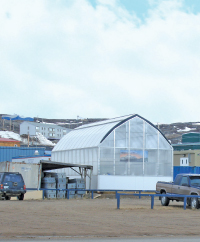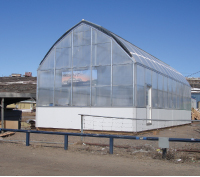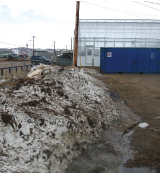
Features
Business
Grower Profiles
Greenhouse gardening catches on in Iqaluit
August 22, 2008 By Sara Minogue
Scientists studying climate change in northern Canada
have recently used satellite photos to document a “greening” effect.
That is, they’re finding vegetation above the treeline is growing
lusher and greener earlier than usual. They’re suggesting this green
wave will last longer than in the past, thanks to warmer temperatures.
 |
| Above: A greenhouse is quite unique in Nunavut. Photos by Sara Minogue Below: The 90-square- metre Iqaluit Community Greenhouse, which opened in June of 2007. |
 |
Scientists studying climate change in northern Canada have recently used satellite photos to document a “greening” effect. That is, they’re finding vegetation above the treeline is growing lusher and greener earlier than usual. They’re suggesting this green wave will last longer than in the past, thanks to warmer temperatures.
They might now notice a particularly bright green spot concentrated into 90 square metres within the capital of Nunavut – the new Iqaluit Community Greenhouse.
Atop the dirt and the dust where rich, spongy tundra used to be stands the greenhouse in marked contrast to buildings around it
in treeless Iqaluit.
It’s the only all-glass structure in a town where a number of buildings have few windows at all in a bid to conserve heat in winter. The greenhouse’s openness and airiness is so unlike other buildings whose chief architectural feature is their strong resistance to snow and cold.
But don’t say this greenhouse doesn’t belong. John Lamb, president of the Iqaluit Greenhouse Society, will argue fervently that it does. And this greenhouse is not just about gardening. Rather, it’s about how and where we get our food.
Lamb wants to use the greenhouse to prove you can grow vegetables in Nunavut. Ultimately, he’d like this greenhouse to serve as a prototype for greenhouses in all of Nunavut’s 26 scattered communities. The goal is to grow fresh vegetables close to home, rather than relying on the aging fruit and vegetables that are now flown in at great cost to the consumer and the environment.
“You could have people, for the first time ever, getting really fresh produce,” Lamb says.
In Iqaluit, population 7,000 and growing, he recognizes that the vegetables grown in the greenhouse will be a drop in the bucket of the local food supply. But, he says, “this could be a significant contribution in many other communities,” some of which are home to 300 people or less.
The biggest challenge is moderating Iqaluit’s extremes of hot and cold, light and dark. In early June, just as Iqaluit’s white nights were beginning, the greenhouse warmed to 50ºC by noon, “much too hot for plants.”
Lamb contacted Frank Jonkman of Jonkman and Sons in Bradford, Ontario, who installed a vent system that will automatically open when the temperature climbs too high.
Chilly nights are another problem. The greenhouse, like all buildings in Iqaluit, rests on permafrost.
 |
| Melting snowbanks … in June |
To protect the plants during cold nights, Lamb has installed a passive solar system. Included are 20 plastic garbage cans full of water that will absorb heat in the daytime, and slowly release it at night to keep the chill off the plants. A forced-air furnace is also utilized in the winter. The sun will be the only heat source during the summer.
Utilizing the vents, along with a curtain system, Lamb says he can extend the growing season from early April to late September without relying on electricity, which, in Iqaluit, is produced by diesel generators that spew fumes into the air year-round.
To the Inuit, who traditionally relied on a diet of meat, seafood and berries, vegetable gardening is relatively new. But as traditional diets make way for more western versions, greenhouse gardening isn’t a completely foreign concept.
Mary Nashook has been working in the greenhouse on her deck overlooking Frobisher Bay for several years. Every summer, she grows potatoes, carrots, Alaskan snow peas, parsnip and lettuce. Each year, she starts planting in mid May and expects to get fresh radishes every two weeks. “If you want something fresh, you’ve got to do it yourself.”
Nashook is just one of many home gardeners in Iqaluit. Lamb hopes to bring this experience to about 80 volunteers at the community greenhouse this summer, including groups from the elders’ centre and the schools.
Josephina Rueter is on the list of potential gardeners. She teaches Grade 6, and runs an after-school environmental club for Grades 6, 7 and 8 at Aqsarniit Middle School. Some of her students have never seen a garden. “I think it’s a great idea.”
The community greenhouse officially opened in June of 2007. Gardeners concentrated on fast-growing plants, such as climbing peas, beans and lettuce in the plastic beds lined up on benches. Tomato vines will hang from the ceiling.
Vegetables are really the focus, but Lamb says there may be room for flowerboxes along the wall, and outside, where he plans to build a deck and picnic area.
“We hope it will be a place where people will want to come and hang out, to stop and smell the flowers, so to speak.”
Sara Minogue is a freelance writer and photographer in Nunavut.
Print this page